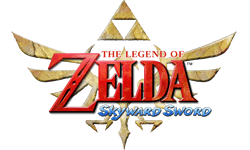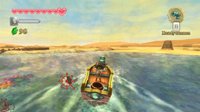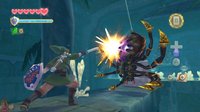|
|

|
PLATFORM
|
Wii
|
BATTLE SYSTEM
|

|
INTERACTION
|

|
ORIGINALITY
|

|
STORY
|

|
MUSIC & SOUND
|

|
VISUALS
|

|
CHALLENGE
|
Moderate
|
COMPLETION TIME
|
40-60 Hours
|
|
OVERALL

|
+ Fantastic use of motion controls.
+ Breath of fresh air for the series.
+ Terrific level design.
+ Beautiful art direction.
- Not all new mechanics are changes for the better.
|
Click here for scoring definitions
|
|
|
When the Wii was first announced, most of us immediately fell in love with the concept. Motion controls were something new that we hadn't had much experience with, and with innovative Nintendo at the helm, there was a lot of potential. Unfortunately, as time passed, the system's software lineup began stressing the casual more and more. As third parties abandoned it and high definition rose to the mainstream, the Wii's relevance to gamers quickly disappeared. Coupled with the natural disadvantages the control scheme held in areas such as camera control, and disappointingly minimalistic implementations of motion controls, many people's opinions on the system were soured. Almost five years to the day since the system first released, The Legend of Zelda: Skyward Sword finally brings motion controls to a truly fantastic level. Not only is it a breath of fresh air for the franchise, but it's possibly the first hardcore Wii title that would be completely impossible without motion controls.
Zelda fans won't be at all surprised to hear that Skyward Sword doesn't do away with the typical series traditions. The game stars the stoic, silent warrior Link in his quest to save the world from a malevolent evil, but continuing in the tradition of Twilight Princess, the tale is far more involving and interesting than older games in the series. This particular incarnation begins on Skyloft, an island floating in the sky and completely cut off from the surface world by a barrier of thick clouds. As the game begins, Link and his childhood friend Zelda are participating in a ceremony that will see Link become a full-fledged member of the guard. As events unfold, a powerful tornado whisks Zelda away beneath the clouds, and it's up to Link to take on the grandiose task of venturing down to the surface to rescue her.
Skyward Sword does a lot of things right in regards to its storytelling. The introduction of Zelda early on as more than just a pretty face in need of rescuing helps make Link's quest feel much more personal and important. This is heightened by the fact that the responses players can choose from when engaging in conversation have an obvious effect on NPC responses. Although the pacing can be fairly slow at times, it simultaneously does a fantastic job of masking the typical dungeon-A-to-dungeon-B flow Zelda games usually rely on. While most characters remain two-dimensional cariacatures throughout the game, the main characters, notably Link and his brutish rival Groose, manage to rise above the fold. That said, the story doesn't really escape from the typical trappings of Zelda games, and it still can't compare to truly story-driven titles.
Where Skyward Sword really sets itself apart is in its gameplay. Like Ocarina of Time before it, Skyward Sword is the revolutionary reimagining of the mechanics that fans have been waiting for. From small changes and additions to traditional mechanics to the massive reworking of the title's prominent swordplay, Skyward Sword is unlike any Zelda title before it.
 Wait, this isn't Wind Waker...
Wait, this isn't Wind Waker...
|
|
For starters, some of Link's basic movement capabilities have been given a nice overhaul. He now has the ability to dash, which not only helps him get around faster, but allows him to run a few steps up a wall, reaching ledges a few feet above him. Dashing, climbing, and certain special attacks deplete his stamina gauge, a new mechanic introduced in Skyward Sword. If he stops dashing, it will gradually recover, but if it drains completely, Link will be momentarily exhausted while it recovers, unable to attack and barely able to move.
The biggest change, and the one most central to the gameplay, is how Link's sword is controlled. In Skyward Sword, it's mapped in a one-to-one relationship with the player's wii remote. If the player swings left, Link swings left. If he swings down, Link swings down. It's incredibly responsive and intuitive, and is an example of just how terrific motion controls can be if they're done well. The gameplay supports this combat style by producing enemies that need to be struck from a certain direction, making even normal foes similar to the big bosses Zelda fans are used to tackling. The motion controls play into the subweapons Link acquires throughout his adventure as well. Bombs can be thrown or rolled by making a similar motion with the remote, the "beetle" item is controlled by tilting the wii remote like a gyroscope, and the bow, slingshot, and clawshot can all be manually aimed by pointing the remote at the screen.
Not every change is a positive one, though. Link's shield now takes damage whenever a player blocks an attack without using a "shield bash", a basic technique performed simply by shaking the nunchuk attachment. Once the shield takes enough damage, it's destroyed completely and Link will need to acquire a new one. As the game progresses, a self-repairing shield becomes available, essentially neutralizing the mechanic entirely, but in the early game, it can become quite frustrating and may even encourage some players to not use their shield at all except against enemies that cannot be defeated without it. While the purpose of the mechanic seems to be to prevent players from relying too heavily on the shield, one can't help but think there are better ways to accomplish the same effect, such as tying blocking into the new stamina gauge.
Certain items are much more frustrating to use in Skyward Sword than in previous titles. While in earlier games players could lock onto enemies when firing ranged weapons like the slingshot or bow, Skyward Sword no longer allows this, requiring players to manually line up their shots. Subsequently, these weapons are much more difficult to use in the fray of combat. Even the sword mechanics can be occasionally imprecise as certain bosses require players to slash in specific directions with very little time to register the new point of attack before the window of opportunity closes. Enemies with lightning-charged swords can be especially annoying, since if they manage to successfully parry, Link gets a nasty shock.
 Believe it or not, this Skulltulla will probably kill you. Several times.
Believe it or not, this Skulltulla will probably kill you. Several times.
|
|
Skyward Sword also introduces a simple crafting system wherein Link can trade treasures he discovers throughout the world for upgrades to his equipment. Interestingly, a mirror system exists for potions, and sees Link collecting bugs which can then be mixed into them (gross) to enhance their effects. As collection subquests go, this is easily one of the more enjoyable and rewarding ones to grace a Zelda title. A third collection subquest exists, but rather than having Link going around searching for hidden items, this one simply requires him to go out of his way to help people by completing sidequests.
The level design in Skyward Sword is also among the most impressive in the series. Of particular note is that the line between exploring the world and exploring a dungeon has blurred considerably. While the sky-world surrounding Skyloft exists as a sort of central hub similar to Hyrule Field of Ocarina of Time, the areas surrounding the various dungeons are as big, if not bigger, than the dungeons themselves, and have their own puzzles to be solved. Even more impressive is how the game manages to keep the areas interesting, even though they're revisited several times over the course of the game. Of particular note is the Lanayru desert, whose time-shifting mechanics make it one of, if not the most impressive Zelda area in the series' history.
The visual style of Skyward Sword is about halfway between the last two console entries to the series. More realistic than Wind Waker, but more fanciful than Twilight Princess, it strikes a nice balance using a gorgeous watercolor shading effect. Although the technical limitations of the Wii unfortunately prevent it from realizing its full potential, it's gorgeous to look at and easily one of the best looking games on the system. The music, as always, is terrific, featuring remixed versions of classic tunes and dozens of beautiful original tracks. The theme when flying through the skies around Skyloft is particularly enthralling.
Like any reimagining of a series, Skyward Sword doesn't get everything right in the first try. Despite everything it does well, there are still several kinks that need to be worked out. That said, it's still the most creative, bold, and arguably important Zelda title to be released in over ten years. If this is a sign of things to come, then Zelda fans have a lot to look forward to.
Review Archives
|









